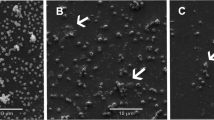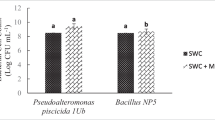Abstract
This study evaluated the use of the prebiotic Active-MOS® (mannanoligosaccharides—Biorigin®) and two probiotics: PAS-TR® (Bacillus subtilis and Bacillus cereus var. toyoi—Imeve®) and Bioplus 2BC® (1.6 × 1010 UFC g−1 de Bacillus subtilis and 1.6 × 1010 UFC g−1 Bacillus licheniformis—Christian Hansen®) tested separately and together, in the diet of Nile tilapia post-larvae during the sex reversal phase. The experiment was conducted in two stages: (i) a total of 2160 3-day-old post-larvae (PL) (10.39 ± 0.85 mm and 12.28 ± 3.15 mg) were used and distributed in 24 tanks of 40 L each (3.0 PL L−1). Growth performance, chemical analysis of carcass, bacterial recovery, and histomorphometry of intestinal villi were evaluated; (ii) 240 tilapia (4.28 ± 0.19 cm and 1.19 ± 0.09 g) from the previous experiment were used and stocked at 10 PL per aquarium. The parameters evaluated were survival and relative protection level after bacterial challenge against Aeromonas hydrophila. Six treatments with four replications in a completely randomized design were used for both experimental stages. Additives in the diet of tilapia post-larvae did not determine significant differences in growth, survival, microbiological, or histomorphometric parameters in this study. Nevertheless, after the experimental infection, advantages on the use of the additives were observed in terms of higher relative protection levels (38.10%) and relative percent survival in fish receiving Active-MOS® + Bioplus 2BC®. Therefore, we recommend the use of synbiotic (Active-MOS® + Bioplus 2BC®) in the farming of Nile tilapia PL with recurrent outbreaks of bacterial diseases during the sex reversal phase.

Similar content being viewed by others
References
Albuquerque DM, Marengoni NG, Boscolo WR, Ribeiro RP, Mahl I, Moura MC (2013) Probióticos em dietas para tilápia do Nilo durante a reversão sexual. Ciência Rural, Santa Maria 43:1503–1508
Aly SM, Ahmed YAG, Ghareeb AAA, Mohamed MM (2008) Studies on Bacillus subtilis and Lactobacillus acidophilus, as potencial probiotics, on the immune response and resistance of Tilapia nilotica (Oreochromis niloticus) to challenge infections. Fish Shellfish Immunol 25:128–136
Apún-Molina JP, Santamaría-Miranda A, Luna-González A, Martínez-Díaz SF, Rojas-Contreras M (2009) Effect of potential probiotic bacteria on growth and survival of tilapia Oreochromis niloticus L., cultured in the laboratory under high density and suboptimum temperature. Aquac Res 40:887–894
Araújo GS (2006) Efeito imunoestimulante dos polissacarídeos sulfatados da alga marinha vermelha Gracilaria caudata na reversão sexual de tilápia do Nilo, Oreochromis niloticus (LINNAEUS, 1766) em condições adversas. Fortaleza. 71f. (Dissertação de Mestrado. Universidade Federal do Ceará. Disponível em: <http://www.repositorio.ufc.br/handle/riufc/1128> Acesso em: 21 fev. 2014
Balcázar J, De Blas I, Ruiz-Zarzuela I, Cunningham D, Vendrell D, Múzquiz JL (2006) The role of probiotics in aquaculture. Vet Microbiol 114:173–186
Balcázar JL, Vendrell D, Blas I, Ruizzarzuela I, Muzquiz JL, Girones O (2008) Characterization of probiotic properties of lactic acid bacteria isolated from intestinal microbiota of fish. Aquaculture 278:188–191
Bernard VH, Nurhidayu A, Ina-Salwany MY, Abdelhadi Y (2013) Bacillus cereus JAQ04 strain as a potential probiotic for red tilapia, Oreochromis species. Asian J Anim Vet Adv 8:395–400
Carrasco LAP, Penman DJ, Villalobos SA (1999) The effects of oral administration with 17amethyltestosterone on chromosomal synapses in Oreochromis niloticus (Pisces, Cichlidae). Mutat Res 430:87–98
Corso CR, Almeida ACM (2009) Bioremediation of dyes in textile effluents by Aspergillus oryzae. Microb Ecol 57:384–390
El-Sayed AM (2006) Tilapia culture. London: Cabi. 277p
FAO (2016) The state of world fisheries and aquaculture 2016. Contributing to food security and nutrition for all. Rome. 200 pp.
Finucane M, Spring P, Newman K (1999) Incidence of mannose-sensitive adhesions in enteric bacteria. Poultry Science, Honduras 78:139
Fuller R (1989) Probiotics in man and animals: a review. J Appl Bacteriol 66:365–378
Gatesoupe FJ (1999) The use of probiotics in aquaculture. Aquaculture 180:147–165
Gatlin DM III, Li P, Wang X, Burr GS, Castille F, Lawrence AL (2006) Potential application of prebiotics in aquaculture. In: VIII Avances en Nutrición Acuícola. VIII Simposium Internacional de Nutrición Acuícola. Universidad Autónoma de Nuevo León, Monterrey, pp 371–376
Genten F, Terwinghe E, Danguy A (2008) Atlas of Fish Histology. Science Publishers, Enfield, NH, USA, pp 223
Ghazalah AA, Ali HM, Gehad EA, Hammouda YA, Abo-State HA (2010) Effect of probiotics on performance and nutrients digestibility of Nile tilapia (Oreochromis niloticus) fed low protein diets. Nat Sci 8:46–53
Gibson GR, Roberfroid MB (1995) Dietary modulation of the human colonic microbiota: introducing the concept of prebiotics. J Nutr, Bethesda 125:1401–1412
Gildberg A, Mikkelsenr H (1998) Effects of supplementing the feed to Atlantic cod (Gadus morhua) fry with lactic acid bacteria and immuno-stimulating peptides during a challenge trial with Vibrio anguillarum. Aquaculture 167:103–113
Irianto A, Austin B (2002) Use of probiotics to control furunculosis in rainbow trout, Oncorhynchus mykiss (Walbaum). J Fish Dis 25:333–342
Ishikawa CM (1998) Quantificação bacteriana e avaliação das lesões em peixes da espécie Oreochromis niloticus (Tilápia-do-Nilo) inoculados ex perimentalmente com Mycobacterium marinum ATCC 927. Dissertação de Mestrado, Faculdade de Medicina Veterinária e Zootecnia, USP, São Paulo, SP. pp 59
Kesarcodi-Watson A, Kaspar H, Lategan MJ, Gibson L (2008) Probiotics in aquaculture: the need, principles and mechanisms of action and screening processes. Aquaculture 274:1–14
Koneman EW, Allen SD, Janda WM, Schreckenberger PC, Winn Jr WC (2007) Diagnóstico microbiológico 6°. ed. Rio de Janeiro: Guanabara Koogan, pp 1488
Lara-Flores M, Olevera-Novoa MA, Guzmán-Méndez BE, López-Madrid W (2003) Use of the bacteria Streptococcus faecium and Lactobacillus acidophilus, and the yeast Saccharomyces cerevisiae as growth promoters in Nile tilapia (Oreochromis niloticus). Aquaculture 216:193–201
Li P, Gatlin DM III (2004) Dietary brewers yeast and the prebiotic Grobiotic™ AE influence growth performance, immune responses and resistance of hybrid striped bass (Morone chrysops x M. saxatilis) to Streptococcus iniae infection. Aquaculture, Amsterdam 231:445–456
Lima ACF, Pizauro JR, Macari M, Malheiros EB (2003) Efeito do uso de probiótico sobre o desempenho e atividade de enzimas digestivas de frangos de corte. Rev Bras Zootec 32:200–207
Lima PCWC, Torres VM, Rodrigues JAG, Sousa JJ, Farias WRL (2009) Efeito dos polissacarídeos sulfatados da alga marinha parda Spatoglossum schroederi em juvenis de Litopenaeus vannamei. Rev Ciênc Agron 40:79–85
Mello H, Moraes JRE, Niza IG, Moraes FR, Ozório ROA, Shimada MT, Engracia Filho JR, Claudiano GS (2013) Efeitos benéficos de probióticos no intestino de juvenis de Tilápia-do-Nilo. Pesqui Vet Bras 33:724–730
Melo DC, Oliveira DAA, Melo MM, Júnior DV, Teixeira EA, Guimarães SR (2009) Perfil proteico de tilápia nilótica chitralada (Oreochromis niloticus), submetida ao estresse crônico por hipóxia. Arquivo Brasileiro de Medicina Veterinária e Zootecnia 61:1183–1190
Merrifield DL, Dimitroglou A, Foey A, Davies SJ, Baker R, Bøgwald J, Castex M, Ringø E (2010) The current status and future focus of probiotic and prebiotic applications for salmonids. Aquaculture 302:1–18
Meurer F, Hayashi C, Costa MM, Freccia A, Mauerwerk MT (2007) Saccharomyces cerevisiae como probiótico para alevinos de tilápia-do-nilo submetidos a desafio sanitário. Rev Bras Zootec 36:1219–1224
Meurer F, Hayashi C, Barbero LM, Santos LD, Bombardelli RA, Colpini LM (2008) Farelo de soja na alimentação de tilápias-do-nilo durante o período de reversão sexual. Rev Bras Zootec 37:791–794
Moran CA (2004) Functional components of the cell wall of Saccharomyces cerevisiae: applications for yeast glucan and mannan. In: International Feed Industry Symposium, 20, 2004, Lexington. Proceedings. Lexington, Alltech, pp 280–296
Mörschbacher EF (2009) Mananoligossacarídeo durante a reversão sexual de tilápia do Nilo. Dissertação (Mestrado em Zootecnia) – Universidade Estadual do Oeste do Paraná – PR. 45p
Newman SG, Mainrich JJ (1982) Direct immersion vaccination of juvenile rainbow trout (Salmo gairdneri) and juvenile coho salmon (Oncorhynchus kisutch) with a (Yarsinina Yuckerli) bacterin. Journal of Fish Diseases, 5:339–341
Oliveira MN, Sivieri K, Alegro JHA, Saad SMI (2002) Aspectos tecnológicos de alimentos funcionais contendo probióticos. Revista Brasileira de Ciências Farmacêuticas 38:1–21
Phelps RP, Popma TJ (2000) Sex reversal of tilapia. In: Costa-Pierce BA, Rakocy JE (eds) Tilápia aquaculture in the Americas, Louisiana: The Aquaculture Society, vol 2, pp 34–59
Popma TJ, Green BW (1990) Manual de produccion aquicola: reversion sexual de tilapia em lagunas de tierra. Asociación Americana de Soya, Arburn, 35p
Popma TJ, Lovshin L (1994) Worldwide prospects for commercial production of tilapia. Auburn-Alabama: Auburn University. 40p
Raa J (2000) The use of immune-stimulants in fish and shellfish feeds. In: Avances em Nutrición Acuícola. Memorial del V Simposium Internacional de Nutrición Acuícola. 7., 2000, Yucatan. Anais eletrônicos. Yucatan: Mérida, 2000. 47–56
Radecki SV, Yokoyama MT (1991) Intestinal bacteria and their influence on swine nutrition. In: Miller ER. Duane EU, Lewis AJ, Swine nutrition, pp 439–447
Ringo E, Schillinger U, Holzapfel W (2005) Antimicrobial activity of lactic acid bacteria isolated from aquatic animals and the use of lactic acid bacteria in aquaculture. Biology of Growing Animals, Chapter 18:418–453
Rotta MA (2003) Utilização do ácido ascórbico (vitamina C) pelos peixes. EMBRAPA Pantanal, 54 p
Sakai M (1999) Current research status of fish immunoestimulants. Aquaculture 172:63–92
Schwarz KK, Furuya WM, Natali MRM, Michelato M, Gualdezi MC (2010) Mananoligossacarídeo em dietas para juvenis de tilápias do Nilo. Acta Scientiarum. Anim Sci, Maringá 32:197–203
Schwarz KK, Furuya WM, Natali MRM, Gualdezi MC, Lima PAG (2011) Mananoligossacarídeo em dietas para larvas de tilápia. Revista Brasileira de Zootecnia, Viçosa 40:2634–2640
Silva DJ, Queiroz C (2002) Análise de alimentos: métodos químicos e biológicos. Universidade Federal de Viçosa, Viçosa, MG, 235p
Sipauba - Tavares, LH (1995) Limnologia aplicada à aquicultura. Jaboticabal: FUNEP, 70 p
Stickney RR (2000) Status of research on tilapia. In: Costa pierce BA, Rakocy JE (Eds.). Tilapia aquaculture in the Americas. Louisiana. World Aquaculture Soc, 2: 21–33
Tachibana L, Dias DC, Ishikawa CM (2011) Probiotic in the feed of Nile tilapia, (Oreochromis niloticus, Linnaeus, 1758) during sex reversal: zootechnical performance and the recovery of probiotic bacteria in the intestine. Bioikos 25:25–31
Telli G, Ranzani-Paiva M, Dias D, Sussel F, Ishikawa C, Tachibana L (2014) Dietary administration of Bacillus subtilis on hematology and non-specific immunity of Nile tilapia Oreochromis niloticus raised at different stocking densities. Fish Shellfish Immunol 39:305–311
Toyama GN, Corrente JE, Cyrino JEP (2000) Suplementação de vitamina C em rações para reversão sexual da tilápia-do-nilo (Oreochromis niloticus). Sci Agric 57:221–228
Verschuere L, Rombaut G, Sorgeloos P, Verstraete W (2000) Probiotic bacteria as biological control agents in aquaculture. Microbiol Mol Biol Rev 64:655–671
Wang YB, Xu ZR (2006) Effect of probiotics for common carp (Cyprinus carpio) based on growth performance and digestive enzyme activities. Anim Feed Sci Technol 127:283–292
Wang YB, Tian ZQ, Yao JT, Li WF (2008) Effect of probiotic faecium, on tilapia (Oreochromis niloticus) growth performance and immune response. Aqua 277:203–207
Ziaeinejad S, Rezaeib MH, Takamic GA, Lovettd DL, Mirvaghefia A, Shakourie M (2006) The effect of Bacillus spp. bacteria used as probiotics on digestive enzyme activity, survival and growth in the Indian white shrimp Fenneropenaeus indicus. Aquaculture, 252:516–524
Author information
Authors and Affiliations
Corresponding author
Ethics declarations
The experiments were approved by the Ethical and Animal Welfare Committee of the Instituto de Pesca de São Paulo (# 01/2015).
Rights and permissions
About this article
Cite this article
de Araújo, E.R.L., Barbas, L.A.L., Ishikawa, C.M. et al. Prebiotic, probiotic, and synbiotic in the diet of Nile tilapia post-larvae during the sex reversal phase. Aquacult Int 26, 85–97 (2018). https://doi.org/10.1007/s10499-017-0201-7
Received:
Accepted:
Published:
Issue Date:
DOI: https://doi.org/10.1007/s10499-017-0201-7




